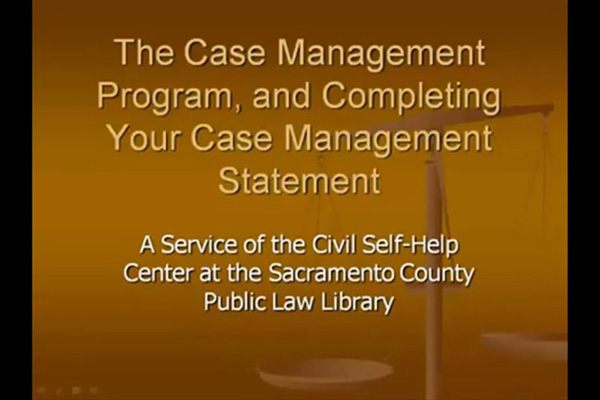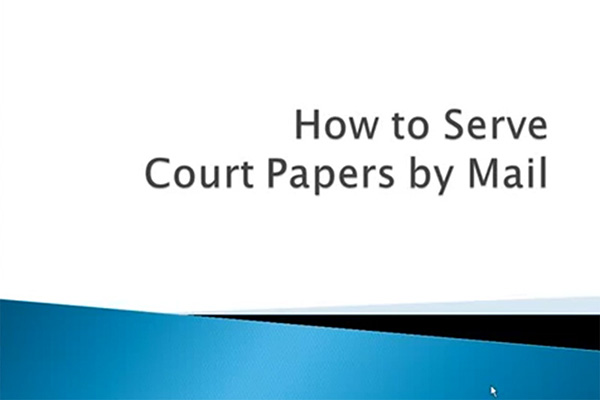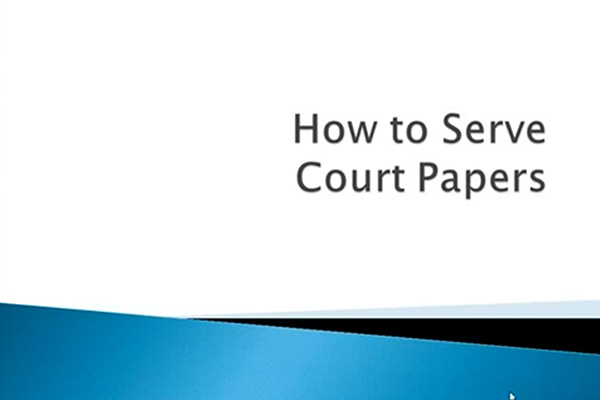Filling Out and Serving Pleadings, Forms, and Court Paperwork Category: Courts and Procedure
Overview
There are very specific rules and procedures for filing and serving court paperwork, which are strictly enforced.
“Pleading” has two meanings in lawsuits. “Pleadings” is the term for the essential papers framing a lawsuit — the Complaint and the Answer or other response, and any cross-complaints or amendments to those papers.
“Pleading paper” is the term for legal-format paper, with numbers down the side. In situations where there is no pre-printed court form, court paperwork must be submitted on pleading paper.
For many common situations, there are pre-printed forms created by the Judicial Council or the county superior court that you can use instead.
Every time you file something in court, you MUST have it served on all other parties. This means someone who is not a party either hand delivers it, or puts it in the mail, then signs a “proof of service” under penalty of perjury.
Forms
Federal Pleading Paper
Pleading Paper – Sacramento Format
Pleading Paper for Google Docs/Chromebook
Declaration Template (Generic)
Pleading Paper (PDF)
Civil Rights: Section 1983
Title 42, Section 1983, of the United States Code is a procedural vehicle by which one whose federal statutory or constitutional rights have been violated can bring an action against state “actors” who commit these violations “under color of law.” The statute was rarely used until 1961, when the Supreme...
Read MoreTROs: Applying for a Temporary Restraining Order in a Civil Case
Warning: This is a complicated procedure with many steps, and you will be expected to follow all the same rules as a lawyer would. You will need to do extensive research and writing, go to court, and speak in front of the judge. If you cannot or prefer not to...
Read MoreResponding to a Lawsuit
Related Guide: Responding to a Debt Collection Lawsuit Basics Filing a response is an important first step for any defendant in a civil lawsuit. By filing a response, you establish that you are contesting the case and requiring the plaintiff to prove their case at trial in order to win....
Read MoreCalculate deadlines to file and serve motions
Determine the legal deadline to file the motion in court. Warning! Some motions have different time requirements--most notably motions for summary judgment and summary adjudication, which require 81 days notice. Check the rules for the motion you are filing. Tip: File the motion as soon as possible. Your reservation...
Read MoreClaims Against the Government
California Tort Claims Act Before you may sue a public entity, you must first file a claim meeting the requirements of the California Tort Claims Act (Government Code §§ 810-996.6). This law applies to public entities such as state, county, and local government agencies or departments, as well as to...
Read MoreShould I represent myself in court?
Adapted in part from shlep: the Self-Help Law ExPress, “Should I go it alone” If you have been sued, or you are planning to sue someone, you may be wondering if it's possible to go to court without a lawyer. It is permitted, but it's not necessarily a good idea....
Read MoreWhat about bottom exhibit tabs?
Exhibit tabs are no longer required in Sacramento County filings.Previously, the court required bottom tabs to separate the exhibits in one copy of each filed motion, as set out in Cal. Rule of Court 3.1100. Now that electronic filing is available, this is impractical. Even if you are filing a...
Read MoreDeclaration tips
Motions are virtually always required to include one or more Declarations. The Declarations are usually the most important part of a motion, because they contain evidence the judge can consider when deciding whether or not the motion must be granted. Declarations become evidence Your declaration must contain only facts you...
Read MoreProving proof of service by mail is false
The other party claims they served me, but I never got it. How do I prove the other party's server lied in their Proof of Service? First, make sure to look everywhere it might be and ask anyone else who picks up your mail if they might have seen it,...
Read MoreTentative Rulings and Hearings in Sacramento Civil Court
Pursuant to Sacramento County Local Rule 1.06, the court in most departments makes a tentative ruling on the motion by 2:00 p.m. the court day before the hearing. You then have two hours to request oral argument, if you choose to do so. If neither party does, the tentative ruling becomes final and...
Read MoreSteps in a Lawsuit: Overview
If You Understand Football You Can Understand a Civil Court Case First Round: Complaint and Answer The first step in any lawsuit is that the person who believes they have been wronged -- the plaintiff -- files a Summons and Complaint (or in some cases, a Petition) and has it...
Read MoreMotions Part 1: Scheduling and Writing Your Motion
Guide to bringing a motion in civil court in California, Steps 1-2. Related Guides This is part one of a series of guides on preparing, filing, and arguing a motion in Sacramento County Superior Court. Motions Part 1: Steps 1-2 Motions Part 2: Steps 3-6 Motions Part 3: Steps 7-9...
Read MoreMotions Part 2: Preparing Paperwork and Filing in Court
Guide to copying and assembling motion papers and filing them in civil court in California, Steps 3-6. Related Guides This is part two of a series of guides on preparing, filing, and arguing a motion in Sacramento County Superior Court. Motions Part 1: Steps 1-2 Motions Part 2: Steps 3-6...
Read MoreNew Civil Home Court system in Sacramento
On November 10, 2025, Sacramento County Superior Court introduced major changes to how it handles law and motion matters and case management hearings in civil cases. Historically, civil cases were assigned to either Department 53 or Department 54 for law and motion hearings, and unlimited cases to a separate department...
Read MoreVolunteer Income Tax Assistance Program (VITA)
Administrative Law

The Internal Revenue Service (IRS) administers the Volunteer Income Tax Assistance (VITA) Program to provide free basic tax return preparation for low- and moderate-income taxpayers. The California State Controller works with the IRS and other agencies to make these programs available in communities throughout California.
Assistance is generally available from February 1 through April 15th. Dates and times vary by location, and some VITA sites require appointments.
SH@LL (Self Help @ the Law Library) (formerly Civil Self Help Center)
Accidents and Torts

SH@LL provides general information and basic assistance to people without attorneys on a variety of civil legal issues. All assistance is provided by telephone or Zoom videoconference. Visit “What We Help With” for a list of qualifying cases.
Eligibility: Must be a Sacramento County resident or have a qualifying case in the Sacramento County Superior Court.
Sacramento County Sheriff’s Department Civil Bureau
Courts and Procedure

The Sheriff’s Civil Bureau can serve civil process for documents such as summons and complaints, restraining orders, bench warrants, evictions and any other court documents. The Civil Bureau also handles wage garnishments, bank levies and seizure of judgment debtor assets.
Family Law Facilitator
Courts and Procedure

Family law self help assistance, including forms assistance, file review, preparation of orders and judgments and other forms of procedural assistance. Also assists with Domestic Violence Restraining Orders, Elder Abuse Restraining Orders, Probate Guardianship, and Limited Conservatorship cases. Eligibility: Must have family law case in Sacramento County Superior Court.
Civil Self Help Services
Courts and Procedure

Civil Self-Help Services (SHS) helps people without lawyers who have questions about simple issues related to a civil case. They can give you general information and help you prepare your own forms in the area of civil law. Common topics include civil harassment restraining orders, petitions for change of name/gender, and expungement of criminal convictions.
Ex Parte Applications: Ask the Court for an Order as Quickly as Possible
“Ex parte” is a Latin legal term for “from one party.” An Ex Parte Application is used by one party to ask the court for an order, such as an order changing a hearing date or deadline, without the usual notice to the other parties to give them time to...
Read MoreResponding to a Debt Collection Lawsuit (Answer-Contract)
When a lawsuit is started against you, you will be served with a Summons and Complaint. Ideally, these will be personally served (delivered to you in person). Service is valid even if you refuse to take them, as long as the server informs you that they are legal documents and...
Read MoreCase Management Statement and Case Management Conferences
Under the Case Management Program (CMP), all cases are scheduled for a Case Management Conference approximately six months after filing. You are required to file a Case Management Statement (CM-110) no later than 15 calendar days before your Case Management Conference. This guide shows how to complete that form. Different...
Read MoreClaim Opposing Forfeiture
The procedure described in this guide is used to ask for the return of property that may be forfeited as proceeds of criminal activity. If your property is the subject of forfeiture proceedings, you will be notified. In Sacramento County, if the property is taken at the time of arrest, law...
Read MoreInjunction by Noticed Motion
If you believe that someone is likely to take an action that will violate your rights, you can ask a court to issue a preliminary injunction prohibiting (“enjoining”) the action until the case between you and the other party is over. It takes more than three weeks to get a...
Read MoreMotion for Mandatory Dismissal – Failure to Bring to Trial within Five Years
California Code of Civil Procedure (CCP) §§ 583.310-583.360 set time periods in which a plaintiff must bring an action to trial. The law creates these time limits to ensure that cases are brought to trial before evidence is lost or destroyed, and while witness memories are still reliable. Additionally, requiring...
Read MoreMotions in Civil Cases
When a party needs an order from the judge, they can file a motion. They must use specific formats and follow particular timelines to do so. The other side can file an Opposition to the motion explaining why the judge should not grant the order, and must also follow the...
Read MoreMotion to Continue Trial and Mandatory Settlement Conference
Rule 3.1332(c) of the California Rules of Court (CRC) allows the court to grant a continuance before or during trial on an affirmative showing of good cause. Each request for continuance must be considered on its own merits. In Sacramento County Superior Court, these motions are heard by the Presiding...
Read MoreNotice of Automatic Stay
Filing for bankruptcy immediately stops all attempts to collect debts included in the bankruptcy from you, including lawsuits. This is known as the “automatic stay.” Perhaps you have been sued, and are planning to file for bankruptcy. Or maybe you are already in bankruptcy, and you have received a summons...
Read MorePeremptory Challenge of a Judge
If you have a case in superior court, and you believe you cannot get a fair and impartial hearing or trial from the judge, commissioner, or referee assigned to your case, California Code of Civil Procedure (CCP) § 170.6 gives you the right to disqualify him or her without having...
Read MorePetition to Remove Mechanics’ Lien
Owners of real estate sometimes find that a contractor has recorded a mechanics lien on their property, and failed to remove it. Contractors and subcontractors can record mechanics’ liens against a piece of real property for work they do on that property. Although the lien automatically becomes invalid if the...
Read MorePersonal Service
Service is a formal way of giving copies of all court documents to all parties in a case. It is a very important step at all stages of lawsuit because it notifies the parties of the existence of a court case, and of all actions taken in the case. A...
Read MoreServing Documents by Mail
All documents you file with the court in your case must be served on all other parties. Some documents, such as discovery requests and responses, are not filed with the court but must still be served. See the videos and Step-by-Step guides on Discovery for more information. Templates and Forms...
Read MoreMotion to Set Aside (Relief from Default Judgment)
If a defendant does not respond to a civil lawsuit, the plaintiff may obtain a default and default judgment, winning the case without the defendant's participation. If the defendant has a valid reason for not responding, such as never being notified, they may file a motion asking the judge to...
Read MoreRequest a Default Judgment by Court
A defendant has 30 days from the date he or she is personally served with your summons and complaint to file a written response, or 40 if you served them by substituted service. (California Code of Civil Procedure (CCP) § 412.20(a) (3)). This is not an automatic cutoff. The court...
Read MorePublication of Summons
Publishing a Notice in the Newspaper When You Can’t Find the Other Party When filing a lawsuit, you are required to serve the other party with your summons and complaint, to notify them of the lawsuit. If the other party cannot be located, you will have to ask the court...
Read MoreWithdrawing Funds from a Blocked Account
A blocked account is a bank or other account created by court order, requiring a court order to deposit or withdraw funds. Blocked accounts are frequently created to protect judgments awarded to minors, or to protect the money of adults who cannot manage their own finances and have therefore had...
Read MoreRequest a Default Judgment by Clerk
WARNING Unless the case is a clear-cut breach of contract case with a written amount due, you will probably need a Default Judgment by Court. Visit Default Judgment by Court for the correct guide. Flow chart to select between judgment by clerk and judgment by court A defendant has 30...
Read MoreLimited Civil Case Status Memorandum
Request for Trial in a Limited Civil Case A Limited Civil Case Status Memorandum (CV/E-202) is a Sacramento County Superior Court local form that tells the judge that one party is ready for trial, whether they want a jury, and how many hours they expect the trial to take. Templates...
Read More



 Back to Search
Back to Search 

